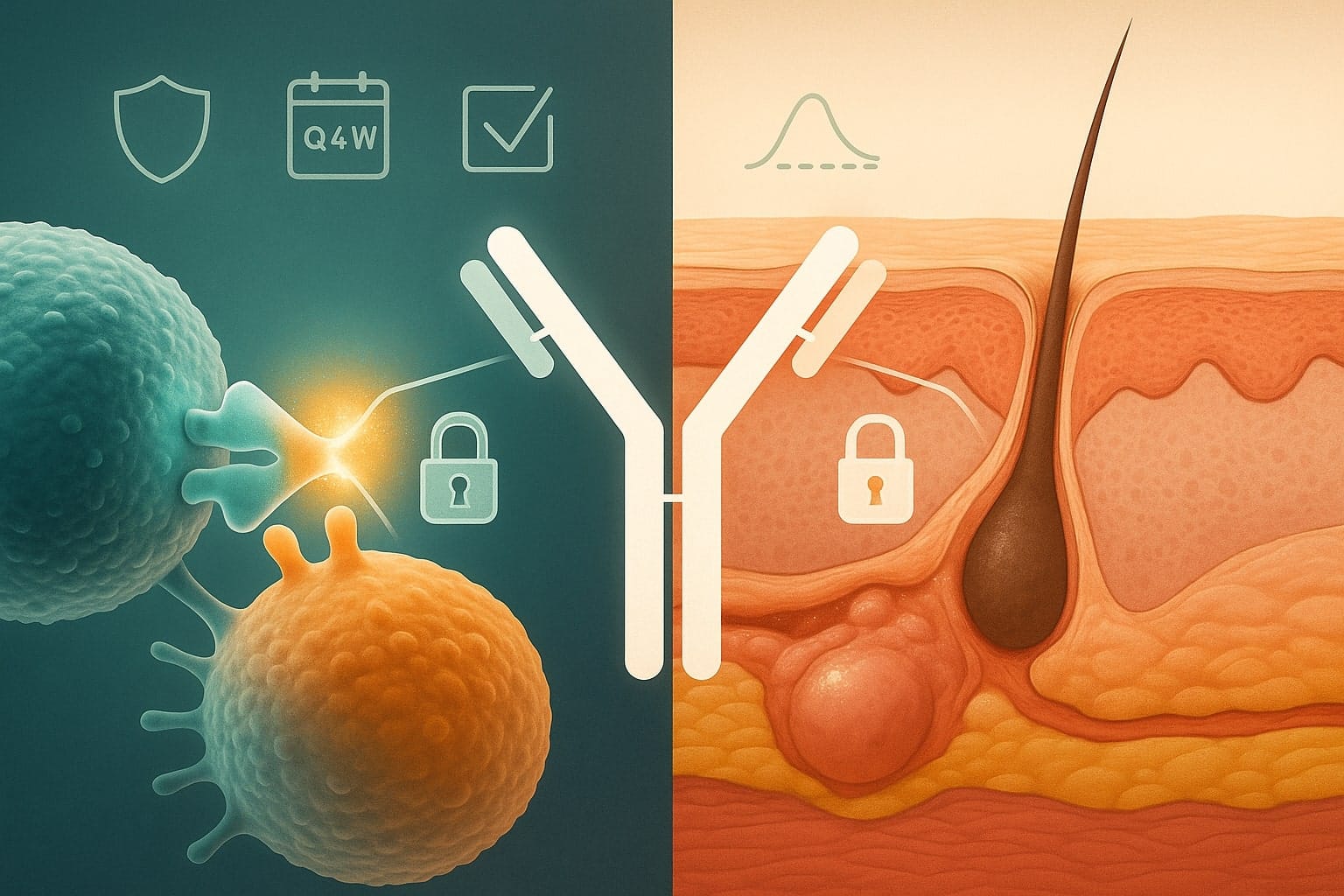AstraZeneca has inked a deal worth “up to” $555 million with San-Francisco startup Algen Biotechnologies to mine new immunology targets using AI-guided CRISPR functional genomics. The structure is familiar—upfront plus R&D, regulatory and commercial milestones, exclusive development rights for AZ—but one feature stands out: no equity stake in the startup. That’s unusual in today’s platform gold-rush and it telegraphs how big pharma increasingly wants algorithmically derived assets rather than ownership exposure to the AI platforms that generate them.
Table of Contents
ToggleWhat’s actually been bought here
According to the companies, Algen’s AlgenBrain™ platform perturbs genes in relevant human cell types at single-cell resolution, then uses causal modelling to map which perturbation trajectories drive disease phenotypes. AstraZeneca gets exclusivity on a defined target set that emerges from this work and, if programmes advance, the downstream rights to develop and commercialise therapies. Total consideration is “up to $555m” across upfront and milestones (no royalty rate disclosed in public materials at time of writing).
Algen’s scientific pitch is not “AI alone” but AI paired with wet-lab CRISPR perturbation: tunable gene modulation + single-cell readouts → models that rank causal targets rather than correlates. That is precisely the kind of upstream de-risking large pharmas crave as they try to lift Phase II success rates.
The “no-equity” tell
Recent AI discovery mega-alliances have often included minority equity as relationship glue (think multiyear discovery corridors with embedded cap tables). Here, AstraZeneca explicitly does not take an equity stake, per early newswire accounts, making this a clean IP-for-cash construct. Why does that matter?
- Governance simplicity: Equity triggers information rights, board observers, and sometimes perception issues around preferential partner treatment. A licence avoids those entanglements.
- Replaceable tooling mindset: If AI is viewed as a toolchain rather than a moated business model, pharma will treat it like a specialised CRO capability: pay for output, keep options open.
- Capital-efficiency optics: For a company targeting $80bn in 2030 revenue, AstraZeneca can afford multiple shots-on-goal without tying up treasury in illiquid stakes.
This posture also hedges against AI platform cyclicality. After years of exuberance, public and private AI-drug discovery valuations have whipsawed; some high-profile players combined or sold, and no AI-discovered medicine has yet reached approval. Equity exposure during a downcycle is optional risk AstraZeneca appears happy to skip here.
Where this fits in AstraZeneca’s AI playbook
AstraZeneca is no stranger to algorithm-enabled discovery. It has run multi-indication collaborations (e.g., BenevolentAI), and has struck targeted AI pacts in biologics design and oncology. The Algen tie-up broadens scope into immunology target origination with a heavier functional-genomics component. Taken together, the pattern is clear: modular AI partnerships matched to therapeutic area and modality, rather than a single, all-purpose platform bet.
Context also matters: management has broadcast a 2030 revenue ambition of ~$80bn and signalled that “disruptive technologies” will help sustain growth beyond the decade. Buying target lists with mechanistic evidence is a rational way to increase the density of credible Phase II entries without building an in-house CRISPR-at-scale engine from scratch.

What the market is missing
Most first-wave coverage touts the headline dollars and Jennifer Doudna’s lab lineage. Three under-reported angles deserve attention:
1) Causal targeting is the budget line that compounds
For immunology, many late-stage failures are “right pathway, wrong node” or “right node, wrong tissue context” problems. A platform that can rank targets by causality in a cell-type-specific manner—rather than correlational omics—attacks that error mode directly. If Algen can supply target dossiers with perturbational evidence plus tractability metrics (genetic constraint, safety archetypes, antibodyability/small-moleculeability), the internal business case for AstraZeneca looks less like a moon-shot and more like portfolio velocity insurance.
2) Equity abstinence increases vendor competition
Skipping equity keeps procurement optionality. AstraZeneca can award the next tranche of target scopes to a different provider if benchmarking shows better hit-quality or translational fidelity elsewhere (e.g., structure-first, patient-tissue-first, or generative-design-first shops). That competitive threat pushes all vendors to publish more, benchmark more—a net positive for translational science. Financial Times
3) Regulators are nudging AI toward supporting evidence, not black boxes
The FDA’s 2025 draft guidance is explicit: AI can support regulatory decision-making when methods and data are transparent and appropriate to the question. A perturbation-plus-AI workflow that yields auditable features and biological priors could travel better with regulators than opaque target picks. Designing with the dossier in mind may become a differentiator.
Will any of this shorten timelines?
A sober view is warranted. No AI-discovered drug has yet been approved, and Phase II attrition remains formidable even for “AI-native” programmes—though there are encouraging Phase I success-rate differentials for AI-designed molecules. The value here is less about magic acceleration and more about fewer dead-ends before expensive human trials.
For immunology specifically, where heterogeneous patient endotypes can doom broad hypotheses, target selection grounded in single-cell perturbation and causal modelling could improve the preclinical-to-clinical hand-off. That won’t eliminate failure; it might shift the distribution—fewer “unknown-unknowns,” more tractable failure modes.
What to watch next (operator’s checklist)
- Disclosure of target areas and modalities. Are we looking at checkpoint-adjacent nodes, stromal/epithelial drivers, or microglia-immune crosstalk? Modalities will hint at internal fit (mAbs, RNA, small molecules, or cell therapy). Early crumbs may surface at scientific meetings or in preprint drops.
- Benchmarking against internal baselines. Does Algen’s hit-to-lead progression outpace AstraZeneca’s historical internal efforts? Expect time-to-candidate and first-in-class vs best-in-class rhetoric if it does.
- IP posture. Watch for filings that combine functional evidence + model-derived features to shore up enablement—important as AI-enabled claims face heightened scrutiny.
- Follow-on design wins. A tell for performance will be whether AstraZeneca expands scope or ports the approach to other TAs (e.g., renal, respiratory). The company’s partnership pattern suggests it will double down where data sing.
- Regulatory dialogue breadcrumbs. If dossiers derived from perturbation-plus-AI start to appear in Type C or end-of-Phase II meetings, you’ll see language seep into investor decks across the sector.
Competitive landscape: collaboration over consolidation—for now
Even as pharmas sign bilateral AI deals, the week’s other headline was a multi-company consortium (BMS, Takeda, AbbVie, J&J et al.) pooling structural data to train shared models—evidence that pre-competitive collaboration is becoming a parallel track to bilateral pacts. AstraZeneca’s no-equity, scope-defined licence with Algen fits this modular, mix-and-match era: keep platforms at arm’s length, ingest their outputs, and participate in shared infrastructure where it accelerates everyone.
Bottom line
The Algen deal isn’t AstraZeneca buying AI; it’s AstraZeneca buying causality—and keeping its cap table clean while doing it. If the approach consistently surfaces safer, more druggable nodes in the messy biology of immune-mediated disease, expect the company to replicate this template across therapeutic areas. If not, it has preserved the freedom to pivot to the next vendor with the next perturbational trick.
Either way, the centre of gravity is shifting: from “own the platform” to “own the validated targets.” For AI-first startups, that means the fastest path to durable revenue may be less about equity rich, multi-year “master” alliances and more about repeatable, benchmarked target-delivery contracts that make the next pharma phone call inevitable.












